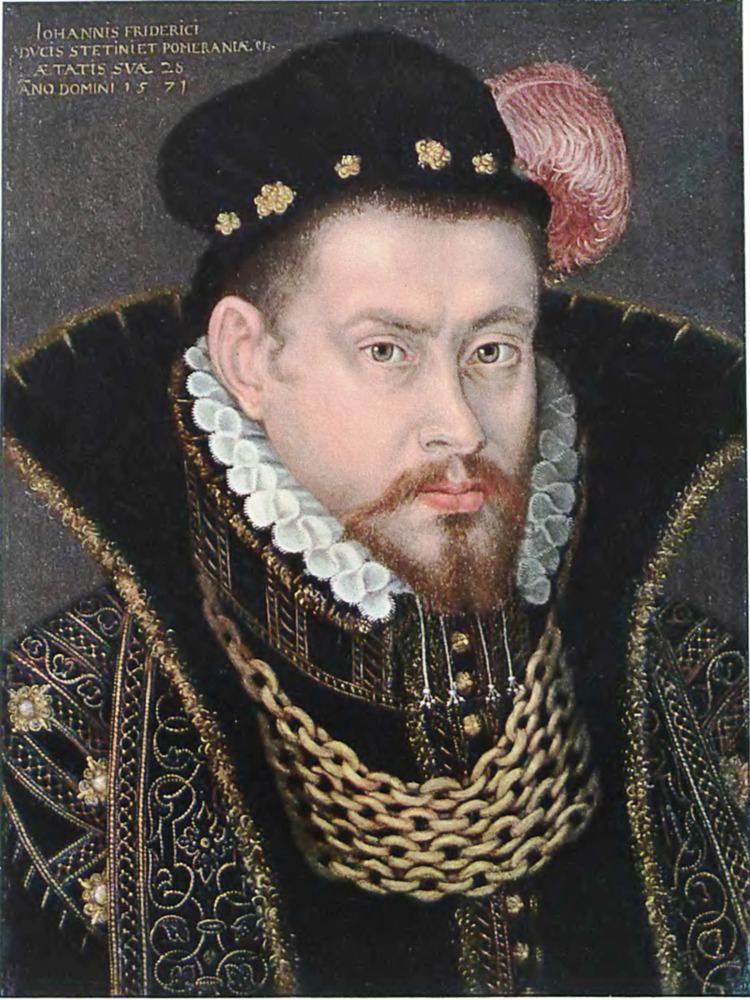Noble family House of Griffins | Name John Duke | |
 | ||
Born 27 August 1542Wolgast ( 1542-08-27 ) Parents Maria of Saxony, Duchess of Pomerania, Philip I, Duke of Pomerania Grandparents John, Elector of Saxony, George I, Duke of Pomerania, Margaret of Anhalt-Kothen, Amalie of the Palatinate Great-grandparents Bogislaw X, Duke of Pomerania People also search for Bogislaw XIII, Duke of Pomerania | ||
Johann Friedrich (sometimes rendered to John Frederick) (27 August 1542 – 9 February 1600) was Duke of Pomerania from 1560 to 1600, and Bishop of Cammin (Kamień) from 1556 to 1574. Elected bishop in 1556 and heir of the duchy in 1560, he remained under tutelage of his great-uncle Barnim XI until he took on his offices in 1567.
Biography
Johann Friedrich was the oldest of ten siblings born to Philipp I of Pomerania-Wolgast and Maria of Saxony. At the age of 14, he was elected bishop of Cammin on 29 August 1556, after his predecessor Martin von Weiher had died on 8 June. Starting with Johann Friedrich, the ducal Pomeranian family would thence exclusively hold this title until the last duke died in 1637, thus ending the considerable independence of the bishopric's territory from the rest of the Duchy of Pomerania. In 1560, the bishopric's administration was reformed accordingly.
When his father died on 14 February 1560, Johann Friedrich nominally became duke of Pomerania but was still under the tutelage of his great-uncle, Barnim XI. While his mother appointed High Stewart Ulrich von Schwerin as administrator of the duchy, he went to the court of Maximilian II, Holy Roman Emperor at Vienna and participated in the war against the Ottoman Empire.
After his return from the war in 1567, Johann Friedrich took on his position as the bishop of Cammin and also his position as the duke of Pomerania, which he provisionally shared with his brother, Bogislaw XIII.
Then 68 years old Barnim XI decided in 1569 to withdraw from his position as a duke, and the duchy was internally partitioned among the male members of the House of Pomerania on 23 May 1569 in Jasenitz (now part of Police), which was approved by the Landtag in Wollin (now Wolin). Johann Friedrich together with his brother, Barnim XII, received the Teilherzogtum Pomerania-Stettin, while his other brothers, Ernst Ludwig and Bogislaw XIII, received Pomerania-Wolgast and Casimir VI received the bishopric of Cammin, which he took over from Johann Friedrich in 1574. Because Bogislaw and Barnim immediately renounced their positions and were compensated with the domains of Barth and Neuenkamp and the domain of Rügenwalde, respectively, Johann Friedrich got to rule his share alone.
Johann Friedrich succeeded in elevating Stettin (now Szczecin) to one of only three places allowed to coin money in the Upper Saxon Circle, the other two places were Leipzig and Berlin. He also advocated against the imperial prohibition of using coins from outside the Holy Roman Empire, arguing that this undermined his duchy's position as a frontier trade center.
In 1570, Johann Friedrich on behalf of Maximilian II, Holy Roman Emperor, hosted the peace conference ending the Northern Seven Years' War between the Swedish Empire and Denmark–Norway. He was the head of the mediators appointed by the emperor. The conference resulted in the Treaty of Stettin.
In 1568, he began with the erection of a residence in Köslin (now Koszalin). In 1577, he rebuilt the residence in Stettin in Italian Renaissance style, thereby razing and replacing parts of the previous palace and the St. Otto's church.
Johann Friedrich also tried to elevate the Duchy of Pomerania's military status in the Upper Saxon Circle to match the position of Saxony and Brandenburg, yet without success. He failed to gain the status of a higher rank for himself and remained on the third rank, Zugeordneter, after the Kreisoberst of Saxony and the Nachgeordneter of Brandenburg. He also failed to get the circle assembly (Kreistag) to approve of granting the Pomeranian duchy an additional Zugeordneter post instead. As a consequence, Johann Friedrich refused to pay his obligate financial share to the circle's treasury, the Kreiskasten.
Johann Friedrich improved the relations with Brandenburg by marrying Erdmut (also Erdmuthe; 26 June 1561 – 13 November 1623), oldest daughter of prince-elector Johann Georg of Brandenburg. He had no children with her.
Johann Friedrich died on 9 February 1600. His sudden death during a party at Wolgast contributed to apocalyptic fears which were especially widespread in 1600. He was succeeded by Barnim XII; who however, outlived his brother by only three years.
